Austin Maxi
| Austin Maxi | |
|---|---|
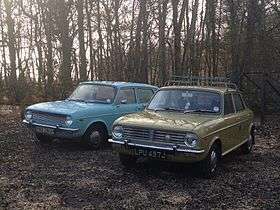 Austin Maxi MkI (left) and Austin Maxi MkII | |
| Overview | |
| Manufacturer | Austin (British Leyland) |
| Production | 1969-1981 |
| Assembly |
Cowley, Oxford, England IMV, Novo Mesto, Slovenia [1] |
| Designer | Sir Alec Issigonis |
| Body and chassis | |
| Body style | 5-door hatchback |
| Powertrain | |
| Engine |
E-Series 1485 cc, 74 bhp and 1748 cc, 84 or 95 bhp[2] |
| Transmission |
5-speed manual all-synchromesh[3] 4-speed automatic optional from 1974 |
| Dimensions | |
| Wheelbase | 104.75 in (2,661 mm)[2] |
| Length | 159 in (4,039 mm)) |
| Width | 64 in (1,626 mm) |
| Height | 54.5 in (1,384 mm) |
| Kerb weight | 2,156 lb (978 kg) |
| Chronology | |
| Predecessor | Austin A60 Cambridge |
| Successor | Austin Maestro |
The Austin Maxi is a medium-sized 5-door hatchback car that was produced by Austin and later British Leyland between 1969 and 1981. It was the first British five-speed five-door hatchback.
History
The Maxi (code name ADO14) was the last car designed under the British Motor Corporation (BMC), and was the last production car designed by Alec Issigonis. Originally under BMC's plan for its new model range, which it had been developing since 1965, the Maxi was to have been called the "Austin 1500" and a saloon version the "Morris 1500" was to follow in the autumn.[4]
However, upon the merger of BMC and Leyland the new management abandoned the four-door saloon notchback and developed the Morris Marina instead. The Marina was a rear-wheel drive car available as a saloon, coupe or estate.
The new chairman Lord Stokes decided to also change the hatchback's name to the Maxi in homage to the Mini of 10 years earlier. All Maxis were produced at the Cowley plant in Oxford, although the E-Series engines were made at a brand new factory at Cofton Hackett in Longbridge.
It was launched in Oporto, Portugal, on 24 April 1969 in a blaze of publicity, being one of the first cars to appear on the BBC's new car programme Wheelbase, a forerunner to Top Gear. It was also the first car after the creation of British Leyland. It followed the five-door hatchback pattern of the French-produced Renault 16, which was European Car of the Year following its launch in 1965.
Underneath the Maxi's practical and spacious bodyshell lay an all-new front wheel drive chassis, which was interlinked with an innovative five-speed manual transmission. The latter suffered from notorious problems with its control linkage, especially in early models which had a cable-operated linkage prone to cable stretch and other problems. These were noted by autotesters such as Vicar in Today's Driver (1969), who wrote: "This is probably a good idea that just needs a little bit of working on."[5][6] The later rod linkage was less problematic. All models were prone to problems brought on by the "cogs in the sump" layout, whereby the gearbox and engine shared a common oil supply. The clutch oil seal was also prone to leakage.
Power came from a 1485 cc, E-Series petrol engine which would later find its way into other British Leyland products such as the Austin Allegro. The 1750 and twin-carburettor 1750 HL models, added to the range in 1971, offered good performance by the standards of this era, with a top speed of 97mph, while the smaller-engine version could exceed 90mph.
Despite the new platform, the Maxi's styling suffered from the decision to save tooling costs by carrying over door panels from the Austin 1800 "Landcrab", which effectively made the Maxi resemble a scaled down version of that car – a design which was by then five years old, at a time when curvaceous "coke bottle" styling (typified by contemporaries such as the Ford Cortina Mk III and Hillman Avenger) was very much in vogue, contrasting sharply with the Maxi's very obvious mid-1960s looks. Another styling ambition for the car was a four-door saloon version, to compete directly with the Ford Cortina. A prototype was built, badged as a Morris, but it was not put into production, since the booted extension made the Maxi almost the same size as the 1800 model.
The Maxi featured a spacious interior, comfortable passenger accommodation, competitive pricing and reasonable running costs, but it was let down by a dull interior and poor build quality, although it was not as notorious for its failings as the Austin Allegro and Morris Marina were during the 1970s.
One unusual feature of this car was that the rear seat back, as well as folding forward as in a conventional hatchback, also folded back. In combination with fully reclining front seats this gave satisfactory, if spartan, sleeping accommodation.
Towards the end of the Maxi's life, in 1980, a lightly revised model was marketed as the "Maxi 2".
End of production
On 8 July 1981, the Austin Maxi's 12-year production life came to an end.[7] Its effective replacement, the Austin Maestro, which also replaced the smaller Allegro, was introduced in March 1983. The next new model in its sector was the Austin Montego saloon, launched in April 1984 and designed to fill the gap in British Leyland's Austin Rover range left by the demise of the Morris Ital and Austin Ambassador.
The Maxi production lines at Cowley were turned over for production of the Triumph Acclaim, which was launched in September 1981.
Despite its practical design and remarkable space efficiency (it is shorter, narrower and lower than the sixth generation Ford Fiesta),[8][9] the Maxi never came close to reaching its projected sales targets. BL management decisions involving the Maxi had significant knock-on effects to the rest of the car line-up. BL marketing decreed that the Maxi should be the only car in the range to feature a hatchback. This stance was continued until the 1980s and prevented the Morris Marina, Austin Allegro and Princess models gaining hatchbacks despite those designs all being capable of receiving them. The only other BL cars to have a hatchback layout were the Austin Ambassador (a revised Princess) and the Rover SD1, which was a large "four-door coupé/hatch", thus leaving the company without a car to compete with the up-coming generation of hatchbacks from Europe, and squandering the lead that BMC and BL had gained in this field. The success of the mid-1970s Volkswagen Golf and Volkswagen Passat hatchbacks shows the scale of the missed opportunity.
Popular culture
On 1 July 1969 John Lennon crashed a white Maxi on the single track A838 road near Loch Eriboll in the Highlands of Scotland. He was on his way to visit his uncle in Durness with Yoko Ono, his son Julian and Yoko's daughter Kyoko.
Originally they had set off from Tittenhurst Park, his country home near Ascot in his Mini Cooper, however it soon became apparent that it was too small in which to drive all the way to Scotland, so they stayed overnight at his relatives' home in Liverpool where he rang Apple Records and arranged for a driver to bring the "staff" car, a recently acquired Snowberry White Austin Maxi with full length white webasto roof; it also featured a silver apple mounted on the radio speaker top of the front fascia.
Next morning Yoko and John transferred all their luggage over and his driver took the Mini back to Tittenhurst, and the four set off north again to Northern Scotland, stopping briefly in Windermere and Edinburgh. It was whilst driving the narrow A838 road that John panicked when he saw another car approaching him and sent the Maxi headlong into a ditch. While the children escaped relatively unhurt, John received a gash to his forehead and Yoko injured her back, resulting in a hospital stay in Golspie's Lawson Memorial Hospital for five days where he was treated by Doctor Michael Simpson. After they returned to London, John arranged for the Maxi to be placed on a plinth outside his Tittenhurst home as an homage to their luck, where it stayed for the next few years, during which time Julian took the silver apple from the dash and kept it as a keepsake, though it was auctioned many years later, also John had its steering wheel removed and it was hung up in his billiard room in the house. When John and Yoko finally left the UK for New York City, John sold Tittenhurst to Ringo Starr who immediately had the Maxi crushed.
Also in 1969 Mars Confectionery UK ran a competition entitled "Maxis from Mars" where a number of white Austin Maxis were driven around the country with numbers on the doors. If the number inside a Mars bar wrapper matched the Maxi a customer would see driving around, then he or she won the car. One lucky winner in Corby was so happy with winning one that the prize Maxi still survives to this day.
In 1972, a married couple escaped the Soviet quarter of Berlin at Checkpoint Charlie in the back of a Maxi. Once over into the western sector, the British Royal Military Police and the West German Polizei were so surprised that two people could fit into a Maxi's boot, that it was then taken up by Leyland West Germany and re-created in a television advert shown across West Germany, Switzerland and Austria.
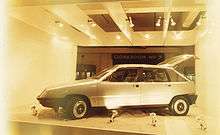
Also in 1972 at the Earls Court Motor Show a competition was staged by The Daily Telegraph, the Institute of British Coachbuilders and Motor Manufactures (later incorporated into the Society of Motor Manufacturers and Traders) to design a futuristic concept car based on a Maxi. The winning design was done by young talented designer Chris Field, and the prize was to have his design on paper turned into reality. The "Aquila" was constructed by Woodhall Nicolson, of Halifax with help from Lucas, Smiths (Motor Accessory Division & Radiomobile) and Triplex. The resultant car was then exhibited at the 1973 show and then given to Field. He then went on the design speed cycles with help from Lotus and his designs for high speed cycles have been used through subsequent Olympic teams. The car itself still survives at Poole in Dorset.
In 1975 Dunlop Tyres, keen to prove its new "Worldbeater" tyre range, drove two white Maxi 1750HLs around the globe, visiting Europe, the Middle East, India, Australia and through the USA. Upon their return to the UK, Dunlop made an advert featuring a similar Maxi using some footage shot on the trip, in which the wife says to her husband that she is "popping down the shops" while he watches the Saturday afternoon sport. She then proceeds to drive the Maxi onto a hovercraft and go past the Eiffel Tower, across Saint Peter's Square, along the Saudi Highway and on to the Taj Mahal. She then walks back into the house, while the football results are on, carrying exotic Indian shopping and her husband looks on in surprise.
From 1975 up until 1980 British Leyland supplied the Lawn Tennis Association every year with official "Wimbledon" Maxis. These were standard single carburettor 1750s but fitted with HL velour seat trim and extra sound proofing. Afterwards they were sold through local Surrey dealers as ex-demonstration cars.
In November 1979 during the Islamic Revolution in Iran, Martin Williams, the First Secretary at the British Embassy in Tehran, rescued five American diplomats who had managed to escape the stormed US Embassy, in his own private British registered orange Maxi complete with its GB sticker.[10] Once rescued, the diplomat then discovered that the British Embassy had now also been overrun, and so undertook a treacherous drive across Tehran to the north of the city to the British compound of Gholhak.[11] Once at Gholhak, the British diplomats and families smuggled the Americans in the Maxi again to the home of a Thai cook who worked for someone at the US embassy. Ten days later they moved on to the home of the Canadian number two diplomat from where the CIA hatched a plot to rescue their diplomats using Canadian passports and posing as movie makers. This was the basis for the US film Argo (2012). However, in this dramatization, the British role (and subsequently the Maxi's) were written out, as director Ben Affleck stated he wished to make the escaped diplomats look helpless and desperate to the studio audience.[12]
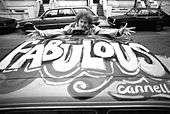
In 1991 Punk revival band Fabulous used a Maxi as their "Fab-Mobile" decked out in Punk-art graffiti The 1750 was registered as FRK315T and according to the DVLA website was last taxed in April 1993
In Christmas 1995 Paul Smith Mail Order issued a catalogue featuring a Sandglow Maxi 1750. Entitled "The 1995cc" meaning 1995 Christmas Collection, It was produced in the style of the 1978 Maxi UK Sales Brochure and featured winter woolen hats and scarves, leather driving gloves, wallets and designer watches..
Timeline

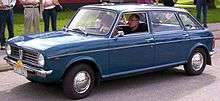

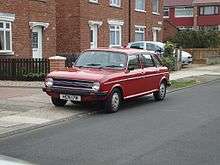
- May 1969: Introduction of the Maxi 1500 5-door hatchback with transversely-mounted 1485 cc E Series engine and 5-speed manual gearbox driving the front wheels, independent suspension with hydrolastic shock absorbers (often referred to as "The Cable-Change" models).[13]
- October 1970: Revisions: redesigned front grille with centre badge, bodyside strips, gearchange rods (instead of previous gear cables), better sound insulation, new seat facings, all-new veneered wood dash design and smaller steering wheel. Introduction of the Maxi 1750 with larger 1748 cc engine and revisions as for Maxi 1500. Assembly by IMV in Yugoslavia also commenced in 1970.[14]
- 1971: Alternator fitted to all UK Models, revised direction indicator circuit, matt finish wood dash, 1750 now has its own gold/yellow chequered grill badge.
- 1972: Introduction of the Maxi 1750 HL, with twin SU HS6 carburettor version of the 1748 cc engine, which gave a higher output of 91 bhp (68 kW) at 5250 rpm. Other additional features for the HL were 165 x 13 radial ply tyres, black grille with chrome upper and lower strips, with red "HL" motif fitted, red chequered front badge, front bumper under-riders, chrome exhaust trim, black rimmed hub caps, body coloured mouldings along the sides and rear, electric windscreen washers, 3 spoke-alloy steering wheel with leather-bound rim, padded vinyl dashboard, dipping rear view mirror, vanity mirror on passenger sun visor, front door pockets, simulated wooden gear knob and brushed nylon upholstery.
- 1973: Hazard flashers introduced on UK models. Also with the Austin/Morris 1800, there are body changes to the Maxi to simplify production and reduce costs (the A posts are no longer lead loaded).
- 1974: Optional 4-speed automatic transmission available on 1750 & (from May 1979) 1750 HL.
- 1975: Fuel tank enlarged, revisions to the rear squab bed adaption facility. All models now feature cigar lighter and heated rear window as standard.
- 1976: All export LHD Models now designated "Maxi HL" with specification similar to UK 1750 HL without twin carburettor or three-spoke alloy steering wheel.
- 1977: Austin name officially dropped[15] by BL under recommendation by the Ryder Report. Model now officially designated Leyland (Austin / Morris Division) Maxi. The only subtle difference to the owner was the rear tailgate badge along with the handbooks, so general public and dealers unofficially still called it the same name. Dual circuit brakes now fitted to UK spec cars.
- 1978: All models now have hydragas suspension instead of previous hydrolastic system, and all models now feature electric windscreen washers. The HL loses its three-spoke steering wheel and a walnut finish dash replaces its padded dash.
- May 1979: Introduction of the Maxi 1750 HLS with walnut dash and twin carburettor 91 bhp (68 kW) engine previously restricted to the HL (HL now with the single carburettor and wood dash). All models now feature the same copper colored front grill badge, black wipers and door mirrors, the rear tailgate badge is now located below the trim line, also revised illuminated switches, cigar lighter and revised windscreen wiper control instrumentation. The 1500/1750 now have 'Marle' fabric seat facings replacing the previous PVC "basketweave" leatherette. Single rear foglight now fitted across the range.
- Dec 1979: Maxi 1500 discontinued.
- Aug 1980: Introduction of the Maxi 2 range in 1750 L, 1750 HL and 1750 HLS variations. All models feature new revisions including new bumpers incorporating indicators (front) and reversing lights (rear), new side repeaters, full cover plastic wheel trims and broader side moulding inserts. Inside the instrument bezels were now in matt black, the switchgear was also again revised, the headlight switch was now on the steering column and there was a choke warning light. The L replaced the previous Base model and added LM/MW push button radio, nylon trim, door bins, laminated windscreen and walnut veneer dashboard. The HL gained intermittent screen wipe, velour seats, tinted glass and extra sound insulation. The HLS gained a burr walnut veneer dashboard. However, LHD export Maxi 2s were still referred to as 'Austin' Maxis in sales literature, only one version being available, the single carburettor HL, though unlike the UK spec cars it did not feature a radio as standard.
- 1981: Chrome bumpers replaced by matt black.

- July 1981: Last Maxi 2 rolls off production line, its place at Cowley taken by the new Triumph Acclaim. The very last Maxi, a champagne L model, is now owned by the Gaydon Heritage Motor Centre.
Appearances
- 1969 BBC Wheelbase, Tomorrows World and The Money Programme
- 1971 BBC Doctor Who (Terror of the Autons)
- 1971 BBC Out of the Unknown (Deathday)
- 1974 Film Deadly Strangers
- 1975 LWT The New Avengers, Thames The Sweeney
- 1975 Film Carry on Behind
- 1975 BBC Fawlty Towers, Survivors, HTV Children of the Stones
- 1977 BBC King Cinder
- 1978 BBC Z-Cars, Film Sweeney 2
- 1979 BBC Fawlty Towers (2nd Series), LWT The Professionals (Dead Reckoning), Minder (TV series) (The Bounty Hunter)
- 1980 BBC Dave Allen (Death/Drink Driving Sketch)
- 1981 LWT The Professionals (The Ojuka Situation)
- 1982 Yorkshire Harry's Game
- 1983 Thames Jemima Shore Investigates
- 1985 Film National Lampoon's European Vacation
- 1987 BBC Last of the Summer Wine
- 1990 BBC The Sharp End
- 1993 BBC One Foot in the Grave
- 1996 BBC Our Friends in the North
- 1998 BBC The Lakes
- 1998 BBC In The Red
- 2005 Film Munich
- 2005 BBC Faith
- 2011 Film Killer Elite
- 2015 BBC Cradle to Grave
References
- ↑ http://www.aronline.co.uk/blogs/cars/bmc-cars/11001300/11001300-international-variations/around-the-world-yugoslavia/
- 1 2 Culshaw; Horrobin (1974). Complete Catalogue of British Cars. London: Macmillan. ISBN 0-333-16689-2.
- ↑ "Autotest: Austin Maxi". Autocar. 130. Vol. (nbr 3821). 8 May 1969. pp. 8–13.
- ↑ "The cars : Austin Maxi development story". AROnline. Retrieved 2012-04-08.
- ↑ Today´s Driver, February 1969
- ↑ From "Today´s Driver" February 1969. http://driventowrite.com/2013/11/01/1969-austin-maxi/
- ↑ Adams, Keith. "Austin Maxi development history". AROnline. AROnline. Retrieved 15 May 2012.
- ↑ "1972 Austin Maxi HL technical specifications". Carfolio database. Carfolio.com. Retrieved 15 May 2012.
- ↑ "2012 Ford Fiesta 1.6 Hatchback technical specifications". Carfolio database. Carfolio.com. Retrieved 15 May 2012.
- ↑ I rescued Argo hostages in my orange Austin Maxi... it had a GB sticker on! Hit film lauds American heroes and claims Brits refused to help, but our man in Iran reveals the real story, Daily Mail, 2 March 2013
- ↑ Arthur Wyatt: Consul-General in Tehran who helped the US Embassy staff escape in 1979 but was sorely traduced by the film 'Argo', The Independent, 3 April 2015
- ↑ Barrett and Jacqui Goddard, David (October 20, 2012). "Ben Affleck's new film 'Argo' upsets British diplomats who helped Americans in Iran". The Telegraph. Retrieved October 21, 2012.
- ↑ "The best of the British car industry". AROnline. Retrieved 2012-04-08.
- ↑ Adams, Keith (2011-10-02). "Yugoslav 1100s". AROnline.
- ↑ History of the Company, www.austinmemories.com Retrieved on 13 February 2014
External links
| Wikimedia Commons has media related to Austin Maxi. |
- The Austin Maxi Owners Club
- The unofficial AustinRover Web Resource: Austin Maxi index
- Private Austin Maxi Website, J.D. Meyberg, Germany
- http://www.carmagazine.co.uk/Community/Forum-Landing/Forum-Categories/Topic/?&topic-id=6269